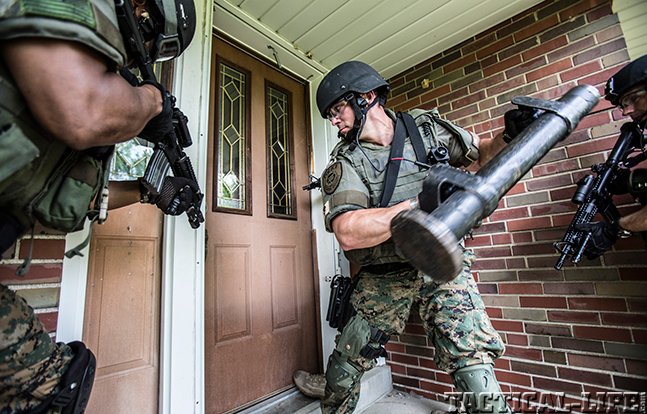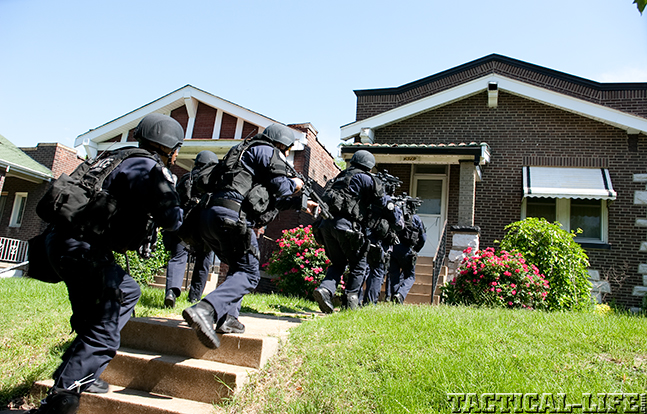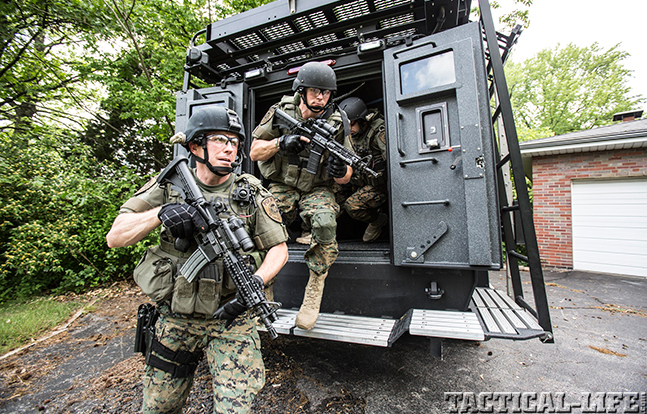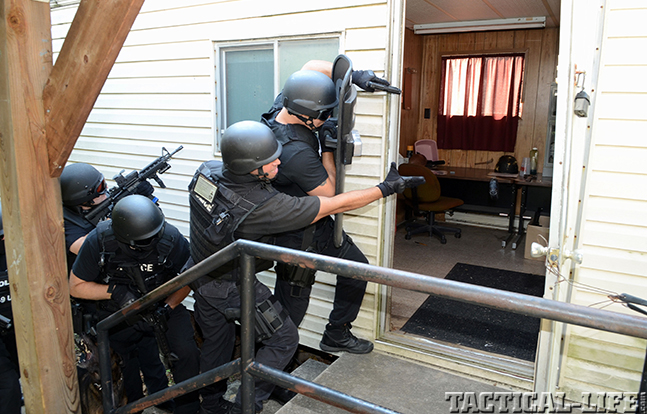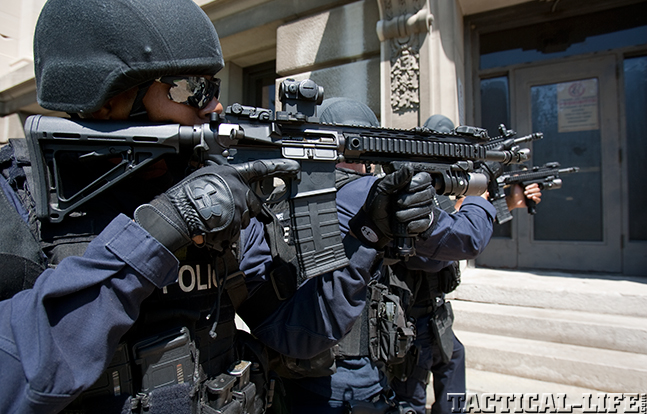For years tactical units have been trained to use dynamic entry techniques to quickly breach, enter and secure a crisis site. The thought process behind this method of entry was to quickly overwhelm and subdue anyone within a structure before resistance could be mounted. This reasoning always seemed sound, as the three tenants of tactical actions have long been seen as speed, shock and violence of action.
While having teams of assaulters storm buildings, lob “flashbangs” and subdue terrorists or criminals has become the daily norm for some law enforcement entities, perhaps there is a better way.
Advertisement — Continue Reading Below
CHANGING DYNAMICS
For many years there has been a symbiotic “push/pull” between military and law enforcement special operations units. At various points in history, each has led the way in terms of tactics, weapons systems and operational knowledge. In short, it has been the operational tempo of these teams that has driven advances. Throughout the 1980s and 1990s, law enforcement special operations teams had typically more breaching operations than their military brethren. After 9/11, however, that situation changed dramatically.
When military special operations forces began to operate more consistently in urban environments, particularly those of Iraq, they learned, often in blood, that the dynamic entry was not always the appropriate technique of choice when clearing a building. Losses mounted as standard dynamic entry techniques were used over and over to secure buildings. Finally, the thought processes behind “routine” clearing began to change, and those techniques have slowly started bleeding over into the law enforcement special operations community.
Advertisement — Continue Reading Below
Speed is the key in dynamic entries. The thought process is that speed in occupying a structure directly correlates to the safety of the team. In most cases, this is true in that action is always quicker than reaction. Put bluntly, if someone does not know you are coming or has not planned for it in advance, then the chances of them being able to react quickly enough to offer substantial resistance is greatly decreased.
In a dynamic entry, forces will quickly breach a target threshold, enter in a rapid fashion and dominate the structure through both superior numbers and the advantage of speed—again, think action versus reaction. Tools such as noise/flash diversion devices, more commonly but inappropriately known as “flashbangs” in the vernacular, are often used to accentuate the elements of surprise and shock without doing harm to anyone inside the contested area. By establishing the shock effect and proceeding very quickly through the structure, officers usually do not meet resistance—there simply isn’t enough time for the suspects to react, and they’re quickly taken into custody.
Where there is a problem, however, is when the suspects are, as Jeff Cooper once proclaimed, “prepared to repel boarders.” In those instances where suspects are prepared and expect the entry to take place, it is fairly common for the assault team to take rounds, and often injuries.
Advertisement — Continue Reading Below
ALTERNATE APPROACHES
As combat losses began to build for military special operations units in both Iraq and other places around the globe, it became evident that a safer way needed to be put into practice. The opposite of a dynamic entry has long been known as a “deliberate entry.” Not to be confused with a “covert entry,” or sneaking into a structure, a deliberate entry is a very slow and methodical entry into and clearing of a structure.
In a deliberate entry, time slows down. No longer is speed paramount; now safety is gained from using cover from materials inside the structure or cover that is brought inside by the entry team in the form of ballistic shields. Every attempt is made to visually clear as much of an area as possible before moving in to occupy it.
Advertisement — Continue Reading Below
This is a very time-consuming process that may, for some buildings, take hours. However, entry through any funnel, such as a doorway, must be done rapidly once you are committed—even in a deliberate clearing. To stall in the “fatal funnel” is to invite disaster, as the assaulter is at great risk during this moment.
So, is there a better way to take down a building? Is there a method that preserves all of the advantages gained from the speed of a dynamic entry as well as the safety of using a deliberate entry method? A “beachhead” assault technique may be just the answer.
In a beachhead (or, more properly, a “limited incursion”) entry, assault forces will dynamically enter and secure the primary breach point, typically through one of the doors, and occupy the room immediately adjacent. From there, the entry team has a variety of options. Once a secure footprint has been achieved inside the building, time becomes an ally.
Advertisement — Continue Reading Below
Once the beachhead has been established, several options become viable, including verbally demanding the surrender of suspects still inside structure, introducing chemical munitions through select portals to drive suspects to the entry team, or slowly and carefully beginning to expand the secure footprint within the building, clearing as you go. No longer are you so committed that you “overrun” your safety net, yet you are also not exposed for any great period of time getting a secure “work area” established.
Having a fully equipped entry team suddenly inside a residence is definitely an attention getter, and psychologically, it begins to break down the resistance of any suspect, all before any contact is actually made. A great deal of limited-incursion entries see the suspects surrendering in much the same fashion as takes place during a high-risk traffic stop—they are simply instructed in how and when to come to the entry team, and in what fashion they are going to be taken into custody.
Advertisement — Continue Reading Below
DIVIDE & CONQUER
While a limited-incursion entry is not appropriate for every contingency, it is perhaps the safest way to clear a single-level structure, or at least achieve a completely secure floor from which to work in order to deal with multi-level structures when hostages are not present.
As always, there is much more that goes into actually clearing a structure than the technique that is used. For those who are interested, there are a variety of entities that teach the finer points of limited-incursion entries and the various porting techniques that should be thoroughly learned prior to actually putting the tactic into practice.
Advertisement — Continue Reading Below
